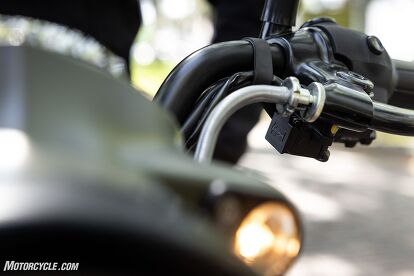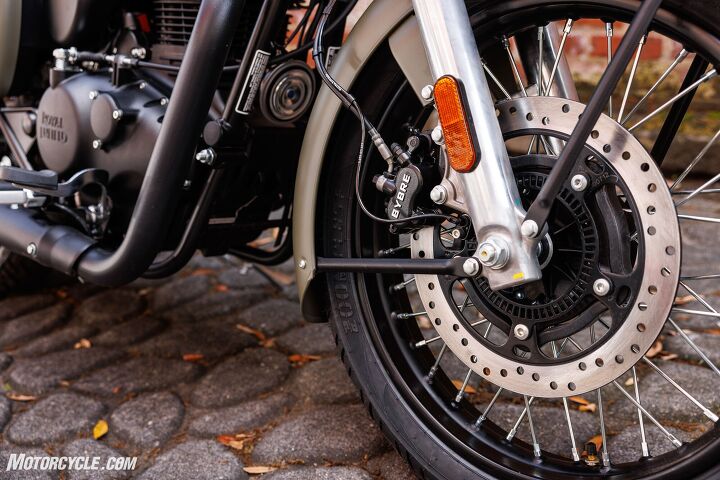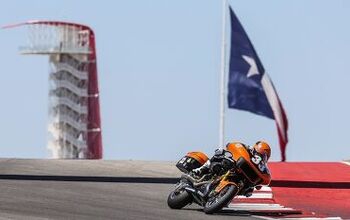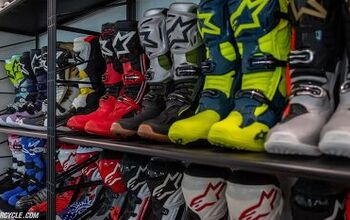2022 Royal Enfield Classic 350 Review - First Ride

Is it worthy of slotting in next to Enfield's latest models?
Things move at their own pace in the South. When it’s not stifling, the warm, humid breeze gently blowing through the Spanish moss-strewn southern live oaks relaxes in a way that you’d be hard-pressed to find elsewhere. It puts you in a southern state of mind – one where slowing down and living in the moment just feels like the thing to do. Royal Enfield’s new Classic 350 is the perfect pairing for such a place. A historic setting for a historic machine.
2022 Royal Enfield Classic 350
Editor Score: 81%
| Engine | 17.5/20 | Suspension | 12.5/15 | Transmission | 8/10 |
| Brakes | 6.5/10 | Instruments | 3/5 | Ergonomics | 7.5/10 |
| Appearance | 8.5/10 | Desirability | 8.5/10 | Value | 9/10 |
+ Highs
- Smooth engine and transmission
- Good looks with attention to detail
- Approachable size
– Sighs
- Questionable manufacturing decisions
- Not quite fast enough for the speediest American freeways
- I’m going to need more seat time
This new model is built from the same platform first introduced as the Meteor 350 a year ago, sharing much of the same componentry. We didn’t have a chance to test that bike, so the Classic would be MO’s first chance to throw a leg over Enfield’s modern air/oil-cooled 349cc Single. With the success of Royal Enfield’s recent models: the Himalayan and Twin-powered International and Continental GTs, I was curious to see if this new platform followed suit. From what I was told by Royal Enfield North America’s President, Krishnan Ramaswamy, we will have more to be excited about, too with a handful of new models to be released in the next 18 months or so (not all of which will be variants of existing platforms).
Everything you need, nothing you don’t
That’s how Ramaswamy described the Classic 350. What you see is what you get with the Classic. Sure, it has ABS, fuel injection, and electric start, but that pretty much covers the technology within. That’s not to say the 349cc Thumper isn’t an example of modern engineering though. Firing to life with the twist of a retro start/kill switch, the Single produces a satisfying thump from its single pea-shooter exhaust pipe.
You can feel the engine pulses at a standstill, but the moment you roll on the throttle the vibes are left behind giving way to a smooth ride thanks to its balancer shaft. It also delivers a bit more pep from a stop than I thought it would. Royal Enfield claims 20.2 hp at 6,100 rpm and 19.9 lb-ft of torque at 4,000 rpm. “It’s all about the torque,” says Ramaswamy. It’s true. For a bike destined to spend much of its time around town and on back roads tasked with mostly recreational riding, but expected to still pull daily duty, it makes sense to put an emphasis on the low end.
On an extended freeway cruise, the Classic 350 managed a top speed of 75 mph with me on board (with my chin bar on the tank). It was relatively easy to reach 65, but the miles per hour start to be more slowly achieved after that. Since you’ll be rowing through the five-speed gearbox quite a bit, I was thankful to find shifting to be smooth and positive, with pull at the clutch lever unlikely to cause fatigue for anyone.
Braking components are supplied by Bybre and get the job done, but at speed, you’ll want to plan on braking earlier than you might normally. Feel at the lever is mush, and the rear brake’s oversized pedal doesn’t allow for much finesse. It’s when you really try to dig into the braking power that you’re reminded that the Classic 350 does certainly have some heft to it.
The bike feels solid, I kept thinking to myself. Solid. It kept crossing my mind. Solid as in, well put together, giving a feeling of robustness, but at the same time, like a solid hunk of metal – which it is. RE claims 430 lbs with its 3.4-gallon tank 90% full of fuel. Unless you’re trying to stop in a hurry, the Classic carries its weight quite well with much of it low to the ground. The spec sheet says the seat height is 31.7 inches, but I would’ve guessed lower. It is also really well-balanced making low-speed u-turns and other maneuvers easy to carry out.
The suspension works a bit better than I expected as well. The non-adjustable fork uses 41mm tubes with 5.12 inches of travel and it’s a similar story in the rear, though there is a six-step adjustable preload from the twin rear shocks. Hard hits reveal the damping isn’t terribly complex, but normal conditions delivered a compliant ride without feeling too soft – as is often the case on lower-priced machines.
The bike looks somewhat small and is quick to turn around town, though, at highway speeds, the low CoG kept the bike stable. Ergonomically, at 5’8” with 30-inch getaway sticks, I found the Classic 350’s riding position perfectly neutral, though I might prefer the bars rotated back slightly. The bike being well-balanced combined with its low seat height inspired confidence while squirting around cobbled streets, weaving in and out of traffic. Unfortunately, I can’t comment on the machine’s cornering ability as there are no curves in or around Savannah, at least not that we rode.
First impressions are important
But they’re not everything. My first impressions were pretty positive. The Classic 350 is a subjectively good-looking motorcycle with fit, finish, and performance (as far as I could tell) that is worthy of a higher price point than its $4,500 starting MSRP would suggest. That said, I feel the need to explain that our first taste of the Classic 350 did not give us the chance to get much more than just that. The few Georgia natives that joined us on our test ride kept telling stories of how great the riding is up north. “If you’re out here in my neck of the woods (northern GA) give me a shout and I’ll show you some great riding.” Southern hospitality, as they say.
Unfortunately, as swell as Savannah is as a match for the Classic 350, the “lowlands” as I heard it called, of Georgia don’t make for the best proving grounds for motorcycle testing. Most of my time was spent bolt upright (as is evident in the photography) aside from the on-ramp to the bridge crossing into South Carolina where I managed to touch down the oversized accessory footpegs on the Dark model I was piloting. The roads were flat and straight. They kind of reminded me of riding in the middle of the US where I’m from – and also part of the reason I left.
As far as I can tell
The Classic 350 delivers on all of its promises. Everything you need, nothing that you don’t. The machine looked great in the Dark and Signal trims that we got to sample, with nice styling touches that elevate the machine’s presence. They feel tight and well-assembled (even if some components like the handlebar clamp seem puzzling), the transmission is smooth as southern bourbon and the 350 mill is as sweet as a Savannah praline.
I’d like to spend more time with Royal Enfield’s Classic 350 – preferably one clad in Halcyon Forest Green or Chrome Brown when they’re available. It would be nice to live with the machine to see if it could truly be a great-looking all-rounder rather than just a Sunday cruiser. Time will tell, but the Classic 350 seems to be on par with Royal Enfield’s new era of excellent mid-sized machines.
In Gear

Helmet: AGV X3000
- Jacket: REV’IT! Prometheus
- Gloves: Racer Mickey
- Jeans: SA1NT Unbreakable
Boots: Red Wing Iron Ranger
2022 Royal Enfield Classic 350 Specifications | |
|---|---|
| Engine Type | Single-cylinder, air/oil-cooled four-stroke |
| Displacement | 349cc |
| Bore x Stroke | 72.0 x 85.8 mm |
| Compression Ratio | 9.5 : 1 |
| Horsepower | 20.2 bhp @ 6100 rpm (claimed) |
| Torque | 19.9 lb-ft @ 4000 rpm (claimed) |
| Clutch | Wet, multi-plate |
| Gearbox | 5 Speed, constant mesh |
| Lubrication | Wet sump, forced lubrication |
| Engine Oil | SAE 15W-50 API, SL Grade, JASO MA 2 semi-synthetic |
| Fuel Supply | Electronic Fuel Injection |
| Air Cleaner | Paper element |
| Starter | Electric |
| Frame | Twin downtube spine frame |
| Front Suspension | Telescopic, 41mm Forks, 5.1 inches of travel |
| Rear Suspension | Twin tube emulsion shock absorbers w/ 6-step adjustable preload |
| Front Brake | 300 mm Disc, Bybre twin piston floating caliper |
| Rear Brake | 270 mm Disc, Bybre single piston floating caliper |
| ABS | Dual Channel |
| Front Tire | 100/90 – 19″ – 57P |
| Rear Tire | 120/80 – 18″ – 62P |
| Wheelbase | 54.7 inches |
| Ground Clearance | 6.7 inches |
| Length | 84.45 inches |
| Width | 30.9 inches (without mirrors) |
| Height | 42.91 inches (without mirrors) |
| Seat Height | 31.69 inches |
| Curb Weight | 430 lbs (with 90% fuel & oil), claimed |
| Fuel Capacity | 3.43 gallons |
| Electrical System | 12V – DC |
| Battery | 12V, 8 AH, VRLA (Maintenance free) |
| Head Lamp | 12V, H4-60/55W (Halogen) w/ LED Light Guide |
| Tail Lamp | 12V, P21/5W |
| Turn Signal Lamp | 12V, 10W x 2 Nos. |
We are committed to finding, researching, and recommending the best products. We earn commissions from purchases you make using the retail links in our product reviews. Learn more about how this works.
Become a Motorcycle.com insider. Get the latest motorcycle news first by subscribing to our newsletter here.

Ryan’s time in the motorcycle industry has revolved around sales and marketing prior to landing a gig at Motorcycle.com. An avid motorcyclist, interested in all shapes, sizes, and colors of motorized two-wheeled vehicles, Ryan brings a young, passionate enthusiasm to the digital pages of MO.
More by Ryan Adams














































































































































































Comments
Join the conversation
Always love these smaller bikes. Looks-wise, it's great! I started out on an early 80s KZ250. Some over-the-seat Pony Express saddle bags, a small fly screen and rode all over the west and Canada. 38,000 miles in my first two years. I lived in Olympia, WA back then and took many long, multi-day trips. I was in Westlock, Alberta and a guy at a gas station told me "you can't tour on a 250." Yet there I was, no trailer or truck. A different time then of course, with the national speed limit and all. But some of the best times and memories were during those first 2 years back on a motorcycle and with that little 250.
CEAT tires? I think that's a new brand to me.
It's a good looking bike no doubt. Royal Enfields are cool looking in photos. Once I saw them in person I easily noticed the shortcuts and the effects of being built to a price. This even holds true on the 650cc twin models. I was all excited about the Continental GT and INT650 until I saw them in person. Desirability went from an 8.5 judging from photos to a 4.0 in person.
I referenced the "Desirability" rating above. I've always questioned the Motorcycle.com rating system especially desirability. It's such a wishy washy category. And I know each reviewer has their own way of rating things, but in what world does this bike have more desirability than a Harley Nightster or Indian Rogue just to name two of the most recent bikes you have tested? This is a budget beginner bike that can barely get out of its own way. The Harley and Indian are cruisers with modern engines and more than enough power.
If you want to compare desirability to bikes closer in price, let's look at the Ninja 400 (8.5/10) and Z400 (8.0/10). What makes this bike as desirable as the Ninja 400 and slightly more desirable than the Z400? I'd sure as heck choose the latter two before this bike.